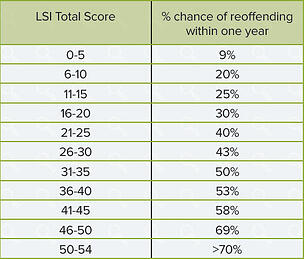This is the 3rd of a 7 part series on The Risk Principle Simplified. Subscribe to our blog and get the series delivered right to your inbox.
Now What?
I have a “risk score.” What does that do for me? There are a variety of reasons why the concept of risk is important. It clearly has important financial and public safety concerns. Incarceration and correctional interventions in general, are expensive in terms of financial and human capital. The research is clear that lower risk offenders are, by definition, not likely to reoffend, even if no intervention is provided.

Source: Andrews, D.A. and Bonta, J.L. (2003). Level of Supervision Inventory-Revised. U. S. Norms Manual Supplement. Multi Health Systems. Toronto.
An individual’s risk score not only helps us to identify whether an intervention is needed but also what to target and at what intensity. “Intervention” refers to both risk containment (i.e., monitoring) and risk reduction (i.e., treatment) efforts. The long-term goal of community corrections is risk reduction. “Reduction” is the action or fact of making a specified thing smaller or less in amount, degree, or size. In order to appropriately target an intervention we need to look at what areas are driving the risk score in order to hone in on the type of intervention. For example, your agency may have highly qualified staff who provide services in assisting with family reunification and employment skills. This however may not be the areas that are driving an individual’s risk and you may need to create an intervention that is targeted toward antisocial attitudes, substance use or other criminogenic needs that are specific to that individual.
What is Intensity?
Once you have identified the areas to target, you need to think about what intensity will be most effective. As we mentioned earlier, high intensity interventions should be reserved for higher risk clients. Other issues may also impact the intensity of an intervention. For instance, when funds are limited (i.e., always), it makes more sense to target those funds for interventions of higher risk offenders, for whom interventions can yield a meaningful result. In other words, spend the money on the client who is most likely to harm society without the intervention. Another reason to consider risk level is that research indicates that the risk level should dictate the “intensity” of intervention provided.
If you think about risk as the size of the probability that an offender will commit another crime, “intensity” is the size of the intervention provided. “Intervention” refers to both risk containment (i.e., monitoring) and risk reduction (i.e., treatment) efforts. Small interventions for high risk offenders will not yield success. That typically does not surprise anyone. However, if a lower risk offender receives a strong intervention, they could get worse! In short, if you over-intervene or under-intervene, the offender tends to get worse (i.e., are more likely to reoffend than before treatment). So, how do you define and measure intensity? That is a good topic for next week’s blog!
In our next blog in this series, we will address "What Does 'High Intensity' Mean?". Subscribe to our blog and get the series delivered right to your inbox.



